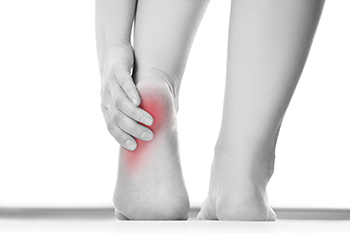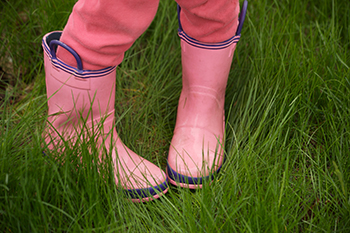
Gout in the heel is a painful condition that occurs when uric acid builds up in the bloodstream, forming crystals that deposit in the joints, including the heel. This typically happens when the body is unable to eliminate excess uric acid, often due to factors like consuming purine-rich foods like red meat or shellfish. Alcohol or dehydration can also play a role. While gout is commonly felt in the big toe, it also can affect the heel. Symptoms of gout in the heel include intense, sudden pain, swelling, and redness, often worsening at night. The pain can be sharp and throbbing, making even the slightest pressure, such as walking or wearing shoes, extremely uncomfortable. The heel may also feel warm to the touch, and the skin around the area may appear inflamed. A podiatrist can diagnose gout through physical exams, blood tests, and joint fluid analysis. They can offer treatments such as medications to reduce inflammation and pain, lifestyle advice to lower uric acid levels, and guidance on proper footwear. If you are dealing with this condition, it is suggested that you make an appointment with a podiatrist for care.
Gout is a painful condition that can be treated. If you are seeking treatment, contact Dr. Eugenio Rivera from Calo Foot & Ankle Specialists. Our doctor will treat your foot and ankle needs.
What Is Gout?
Gout is a form of arthritis that is characterized by sudden, severe attacks of pain, redness, and tenderness in the joints. The condition usually affects the joint at the base of the big toe. A gout attack can occur at any random time, such as the middle of the night while you are asleep.
Symptoms
- Intense Joint Pain - Usually around the large joint of your big toe, and it most severe within the first four to twelve hours
- Lingering Discomfort - Joint discomfort may last from a few days to a few weeks
- Inflammation and Redness -Affected joints may become swollen, tender, warm and red
- Limited Range of Motion - May experience a decrease in joint mobility
Risk Factors
- Genetics - If family members have gout, you’re more likely to have it
- Medications - Diuretic medications can raise uric acid levels
- Gender/Age - Gout is more common in men until the age of 60. It is believed that estrogen protects women until that point
- Diet - Eating red meat and shellfish increases your risk
- Alcohol - Having more than two alcoholic drinks per day increases your risk
- Obesity - Obese people are at a higher risk for gout
Prior to visiting your podiatrist to receive treatment for gout, there are a few things you should do beforehand. If you have gout you should write down your symptoms--including when they started and how often you experience them, important medical information you may have, and any questions you may have. Writing down these three things will help your podiatrist in assessing your specific situation so that he or she may provide the best route of treatment for you.
If you have any questions, please feel free to contact our office located in Bellaire, TX . We offer the newest diagnostic and treatment technologies for all your foot care needs.

When a bunion becomes very large and the front of the foot curves inward sharply, a condition called metatarsus adductus, walking can become painful and shoes may no longer fit comfortably. In more serious cases like this, a special type of surgery can help. Minimally invasive bunion surgery uses tiny cuts and small tools to realign the bones of the big toe and reduce the bump. This approach can also help correct the inward curve of the foot. Because the incisions are small, there is usually less swelling, less pain, and a shorter recovery time compared to traditional surgery. If you have a painful bunion along with a curved foot shape, it is suggested that you see a podiatrist to discuss if this surgical option is right for you.
Foot surgery is sometimes necessary to treat a foot ailment. To learn more, contact Dr. Eugenio Rivera of Calo Foot & Ankle Specialists. Our doctor will assist you with all of your foot and ankle needs.
When Is Surgery Necessary?
Foot and ankle surgery is generally reserved for cases in which less invasive, conservative procedures have failed to alleviate the problem. Some of the cases in which surgery may be necessary include:
- Removing foot deformities like bunions and bone spurs
- Severe arthritis that has caused bone issues
- Cosmetic reconstruction
What Types of Surgery Are There?
The type of surgery you receive will depend on the nature of the problem you have. Some of the possible surgeries include:
- Bunionectomy for painful bunions
- Surgical fusion for realignment of bones
- Neuropathy decompression surgery to treat nerve damage
Benefits of Surgery
Although surgery is usually a last resort, it can provide more complete pain relief compared to non-surgical methods and may allow you to finally resume full activity.
Surgical techniques have also become increasingly sophisticated. Techniques like endoscopic surgery allow for smaller incisions and faster recovery times.
If you have any questions please feel free to contact our office located in Bellaire, TX . We offer the newest diagnostic and treatment technologies for all your foot and ankle needs.

In-toeing, often called pigeon toes, is a common condition where the feet turn inward when walking or running. It frequently appears in young children and, in most cases, corrects itself as they grow. The cause can vary from how the bones in the legs or feet develop to tightness in the hips. While many children with in-toeing have no pain or difficulty, some may trip more often or feel discomfort after activity. Most cases improve naturally without intervention, but there are instances where treatment may be necessary. If in-toeing is severe, causing pain, or not improving over time, a podiatrist can evaluate whether corrective measures such as stretching exercises, braces, or specialized footwear are needed. Addressing concerns early can help ensure proper foot alignment and prevent future issues. If you have concerns about your child’s walking pattern, it is suggested that you see a podiatrist for a proper diagnosis and appropriate treatment.
The health of a child’s feet is vital to their overall well-being. If you have any questions regarding foot health, contact Dr. Eugenio Rivera of Calo Foot & Ankle Specialists. Our doctor can provide the care you need to keep you pain-free and on your feet.
Tips for Keeping Children's Feet Healthy
- Make sure their shoes fit properly
- Look for any signs of in-toeing or out-toeing
- Check to see if they have Clubfoot (condition that affects your child’s foot and ankle, twisting the heel and toes inward) which is one of the most common nonmajor birth defects.
- Lightly cover your baby’s feet (Tight covers may keep your baby from moving their feet freely, and could prevent normal development)
- Allow your toddler to go shoeless (Shoes can be restricting for a young child’s foot)
- Cut toenails straight across to avoid ingrown toenails
- Keep your child’s foot clean and dry
- Cover cuts and scrapes. Wash any scratches with soap and water and cover them with a bandage until they’ve healed.
If you have any questions, please feel free to contact our office located in Bellaire, TX . We offer the newest diagnostic and treatment technologies for all your foot care needs.










